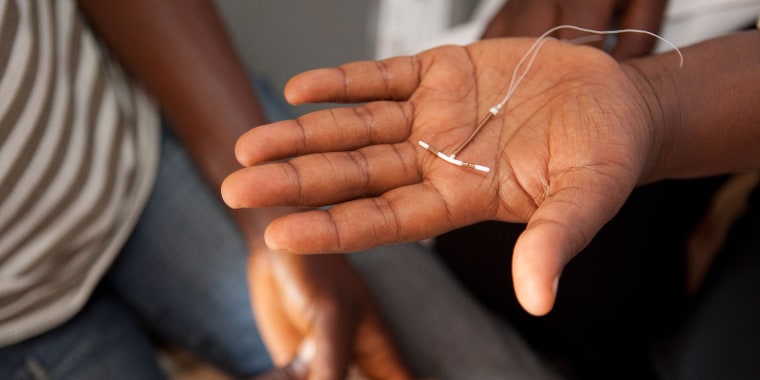As a jolt of pain shot through her body, Shona Spencer felt faint. A nurse started fanning her, as her doctor finished inserting her intrauterine device (IUD), a long acting form of birth control with progesterone on it. While insertion lasts about two minutes, Spencer, like many other women, experienced “extreme” pain.
“I got really lightheaded,” the 35-year-old paralegal from Philadelphia told TODAY. “It hurts.”

Spencer is not alone. IUDs have become increasingly popular in the United States and are the fourth most common type of birth control used after the pill, tubal ligation and condoms, according the Guttmacher Institute. Many women like them because they are long-lasting and reversible. The American College of Obstetricians and Gynecologists says IUDs are one of the "most effective" forms of birth control.
But doctors don't always warn their patients that insertion can cause temporary pain, faintness and cramping.
“The discomfort or pain when the IUD is inserted is real,” Dr. Colleen Krajewski as assistant professor of obstetrics, gynecology and reproductive sciences at the University of Pittsburgh, told TODAY. “I would not discount that pain.”
There are two types:
- Copper IUDs last up to 10 years, have no hormones on them and can lead to heavier periods.
- Hormonal IUDs last between three to five years, have progesterone on it and can stop periods.
Elyse Heckenkamp has had two hormonal IUDs The first insertion felt like a pap smear, just mildly uncomfortable. But the second one was entirely different.
“She couldn’t get it through the cervix and she had to keep dilating it,” the 34-year-old government employee from Louisville, Kentucky, told TODAY. “I was bleeding. I almost passed out.”
While she likes how convenient and effective it is, she’s unsure if she’d go through insertion again.
“It was pretty traumatizing,” she said.
A better way to insert IUDs.
Doctors didn't offer Heckenkamp or Spencer medication for the pain during insertion, they said.
Providing medication seems to be rare and Krajewski says that’s because the research on treating pain during IUD insertion shows mixed results. Still, she offers all her patients numbing medication and says they are relieved to have the choice.
“My patients tend to do better when I use a numbing medication,” she said.“When I offer a numbing medication so many people’s eyes light up. They will say, ‘Wow, thank you.'"
Dr. Anne Davis, an obstetrician-gynecologist at New York-Presbyterian, Columbia University Irving Medical Center, agrees that supporting patients during IUD placement can help them cope. She also conducted research about pain reduction during insertion and that paper found that numbing medications do not help.
“We have tried many things to try to improve that experience and many things have been unsuccessful,” she told TODAY. “The primary aim of that study was to try to find something helpful and simple for the pain women experience with the IUD as it is put in."
The researchers looked at two groups of women who were randomized to either receive lidocaine, a numbing medication on their cervix, or a placebo.
“The numbers, in terms of the pain scores, were exactly the same whether you got the lidocaine or the placebo,” she explained. “All of us were convinced that was helping.”
While the lidocaine didn’t work, the researchers gleaned some interesting info from that study: Providers underestimate how much pain women experienced during insertion. On a scale from zero to 100, for example, women ranked their pain at about a 64.8 on average while providers ranked it about a 35.3.
“There was a discrepancy between what pain we thought they were experiencing and the pain they thought they were experiencing,” she said.
Though, midwives and physicians assistants who insert IUDs “were better at estimating pain.” The study also showed that women who had given birth or experience severe menstrual cramping reported less pain. While numbing agents provide mixed results, doctors can take measures to reduce pain, she said.
“One thing we do know that does improve pain during the placing of the IUD is putting a little anesthesia … into the cervix,” Davis said.
Reassurance can ease IUD pain.
While not all doctors offer anesthesia, she’s found that women often feel better when their provider reassures them during the process.
“Having someone go slower and talk you through it goes a long way,” she said.
Being familiar with the procedure helped Sarah Groomay when she had her copper IUD inserted eight years ago. She asked as many people as she could about their experiences with insertion, which prepared her.
“I had at least one person tell me it was worse than childbirth. It was unpleasant but it wasn’t as bad as I had been given to believe,” the 36-year-old museum employee from Pittsburgh told TODAY. “Absolutely, I would get another (copper IUD).”
The experts encourage women to talk with their providers before insertion for the best experience.
“We need to personalize our discussions,” Davis said. “It is two minutes roughly that you have to get through. Most people are pretty pleased. The satisfaction rate with IUD are really high.”